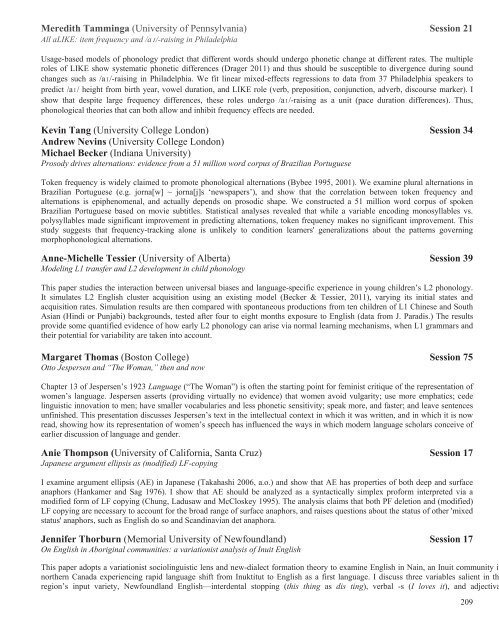here - Linguistic Society of America
here - Linguistic Society of America
here - Linguistic Society of America
You also want an ePaper? Increase the reach of your titles
YUMPU automatically turns print PDFs into web optimized ePapers that Google loves.
Meredith Tamminga (University <strong>of</strong> Pennsylvania) Session 21All aLIKE: item frequency and /aɪ/-raising in PhiladelphiaUsage-based models <strong>of</strong> phonology predict that different words should undergo phonetic change at different rates. The multipleroles <strong>of</strong> LIKE show systematic phonetic differences (Drager 2011) and thus should be susceptible to divergence during soundchanges such as /aɪ/-raising in Philadelphia. We fit linear mixed-effects regressions to data from 37 Philadelphia speakers topredict /aɪ/ height from birth year, vowel duration, and LIKE role (verb, preposition, conjunction, adverb, discourse marker). Ishow that despite large frequency differences, these roles undergo /aɪ/-raising as a unit (pace duration differences). Thus,phonological theories that can both allow and inhibit frequency effects are needed.Kevin Tang (University College London) Session 34Andrew Nevins (University College London)Michael Becker (Indiana University)Prosody drives alternations: evidence from a 51 million word corpus <strong>of</strong> Brazilian PortugueseToken frequency is widely claimed to promote phonological alternations (Bybee 1995, 2001). We examine plural alternations inBrazilian Portuguese (e.g. jorna[w] ~ jorna[j]s ‘newspapers’), and show that the correlation between token frequency andalternations is epiphenomenal, and actually depends on prosodic shape. We constructed a 51 million word corpus <strong>of</strong> spokenBrazilian Portuguese based on movie subtitles. Statistical analyses revealed that while a variable encoding monosyllables vs.polysyllables made significant improvement in predicting alternations, token frequency makes no significant improvement. Thisstudy suggests that frequency-tracking alone is unlikely to condition learners' generalizations about the patterns governingmorphophonological alternations.Anne-Michelle Tessier (University <strong>of</strong> Alberta) Session 39Modeling L1 transfer and L2 development in child phonologyThis paper studies the interaction between universal biases and language-specific experience in young children’s L2 phonology.It simulates L2 English cluster acquisition using an existing model (Becker & Tessier, 2011), varying its initial states andacquisition rates. Simulation results are then compared with spontaneous productions from ten children <strong>of</strong> L1 Chinese and SouthAsian (Hindi or Punjabi) backgrounds, tested after four to eight months exposure to English (data from J. Paradis.) The resultsprovide some quantified evidence <strong>of</strong> how early L2 phonology can arise via normal learning mechanisms, when L1 grammars andtheir potential for variability are taken into account.Margaret Thomas (Boston College) Session 75Otto Jespersen and “The Woman,” then and nowChapter 13 <strong>of</strong> Jespersen’s 1923 Language (“The Woman”) is <strong>of</strong>ten the starting point for feminist critique <strong>of</strong> the representation <strong>of</strong>women’s language. Jespersen asserts (providing virtually no evidence) that women avoid vulgarity; use more emphatics; cedelinguistic innovation to men; have smaller vocabularies and less phonetic sensitivity; speak more, and faster; and leave sentencesunfinished. This presentation discusses Jespersen’s text in the intellectual context in which it was written, and in which it is nowread, showing how its representation <strong>of</strong> women’s speech has influenced the ways in which modern language scholars conceive <strong>of</strong>earlier discussion <strong>of</strong> language and gender.Anie Thompson (University <strong>of</strong> California, Santa Cruz) Session 17Japanese argument ellipsis as (modified) LF-copyingI examine argument ellipsis (AE) in Japanese (Takahashi 2006, a.o.) and show that AE has properties <strong>of</strong> both deep and surfaceanaphors (Hankamer and Sag 1976). I show that AE should be analyzed as a syntactically simplex pr<strong>of</strong>orm interpreted via amodified form <strong>of</strong> LF copying (Chung, Ladusaw and McCloskey 1995). The analysis claims that both PF deletion and (modified)LF copying are necessary to account for the broad range <strong>of</strong> surface anaphors, and raises questions about the status <strong>of</strong> other 'mixedstatus' anaphors, such as English do so and Scandinavian det anaphora.Jennifer Thorburn (Memorial University <strong>of</strong> Newfoundland) Session 17On English in Aboriginal communities: a variationist analysis <strong>of</strong> Inuit EnglishThis paper adopts a variationist sociolinguistic lens and new-dialect formation theory to examine English in Nain, an Inuit community innorthern Canada experiencing rapid language shift from Inuktitut to English as a first language. I discuss three variables salient in thregion’s input variety, Newfoundland English—interdental stopping (this thing as dis ting), verbal -s (I loves it), and adjectiva209
















